
During
the weekend of July 27-29, 2002, Debbie
and I, along with our nephew Damian, visited Manassas, Virginia, site
of
two Civil War battles (The
First
and Second Battles of Bull Run). It only took us 4 hours to drive
to
Northern Virginia (around 230 miles). When we arrived in Manassas, we
first
stopped for lunch at the Shoney's next door to our hotel. The hotel, a
Day's Inn, is on Ball's Ford Road next to Sudley Road, which is next to
the  battlefield
and the Visitor Center. We couldn't have been closer. After we checked
in, we headed over to the battlefield.
battlefield
and the Visitor Center. We couldn't have been closer. After we checked
in, we headed over to the battlefield.
We
covered the sights of the first battle on
the
first day. The First Battle of Bull Run (Manassas) was fought on July
21,
1861. It was the first major battle of the war and would be smaller
than most of the major battles that followed (around
70,000 men in all with only about 18,000 men on each side actually
engaged in combat.).
In the
battle, Union General Irwin McDowell (photo lower left), like a
lot of Union generals in the war, somehow snatched defeat from the jaws
of victory. On July 16, 1861, less then
four months after the attack on Fort Sumter, the untried Union army under McDowell (whose
buried at The Presidio
in
San Francisco) was ordered to march from Washington D.C. south into Virginia.
Waiting for them was the Confederate
army,
led by General Pierre G. T. Beauregard (photo lower right), drawn up
behind Bull Run (a small stream) north of the small town
of
Manassas. On the morning of July 21, McDowell attacked starting the
battle.
McDowell
sent a small portion of his forces west along the Warrenton Pike
towards the Stone Bridge over Bull Run. This however, was not is main
attack but only a feint. His main force crossed Bull Run further north
at Sudley Ford (modern day
route
234) and attacked the Confederate left flank on Matthew's Hill.
Fighting raged throughout the day as the McDowell's army did well and the Confederate forces were driven back to Henry Hill. It would be here that General Thomas J. Jackson earned the nickname “Stonewall.” When Confederate General Bernard Bee found Jackson and his Virginia Brigade on Henry Hill he exlaimed, “The Enemy are driving us.” Jackson, a former U.S. Army officer and professor at the Virginia Military Institute, is said to have replied, “Sir, we will give them the bayonet.” Bee exhorted his own troops to re-form by shouting, “There is Jackson standing like a stone wall. Let us determine to die here, and we will conquer.”
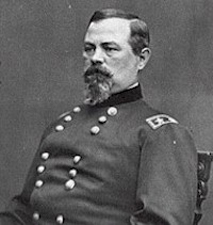
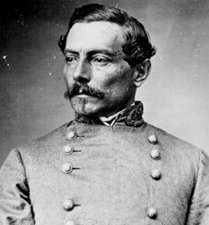 On Henry
Hill is a reconstruction of a farm house that was destroyed during the
battle. At the time of the battle, Judith Carter Henry, an
85-year-old widow and invalid, was on her bed, unable to move. As the Union artillery commander,
Captain James B. Ricketts, began receiving rifle fire, he concluded
that it was coming from the Henry House and turned his guns on the
building. One of the
casualties of the artillery fire was Henry as a shell crashed through her bedroom wall
and tore off one of her feet and inflicted multiple injuries, from
which she died
later that day.
On Henry
Hill is a reconstruction of a farm house that was destroyed during the
battle. At the time of the battle, Judith Carter Henry, an
85-year-old widow and invalid, was on her bed, unable to move. As the Union artillery commander,
Captain James B. Ricketts, began receiving rifle fire, he concluded
that it was coming from the Henry House and turned his guns on the
building. One of the
casualties of the artillery fire was Henry as a shell crashed through her bedroom wall
and tore off one of her feet and inflicted multiple injuries, from
which she died
later that day.
Late in
the
afternoon, after vicious fighting back and forth on Henry Hill,
Confederate
reinforcements, led by Jackson, broke the Union right flank. The Union soldiers heard for probably
the first time a sound that would bring
instant chills in the days to come, a shrill, yelping fox hunter's
call, an eerie quaver that was to become
known as the "Rebel Yell." The Federal
retreat rapidly
deteriorated into a rout. It would later be called "The Great
Skiddaddle". Although victorious, Confederate forces were
too disorganized to pursue. Confederate General Bee (mortally wounded
and would die the next day) and Colonel Bartow
(the first Confederate
brigade commander to be killed in the Civil War) were killed. After the battle, George Templeton Strong
wrote in his diary, “Today will be known as BLACK MONDAY. We
are utterly and disgracefully routed, beaten, whipped by secessionists”.
By July 22, the shattered Union army reached the safety of Washington D.C. This battle convinced the North that the war would be a long and costly affair. McDowell was relieved of command of the Union army and replaced by Maj. Gen. George B. McClellan, who set about reorganizing and training the troops. In their defeat the North who lost 2,900 casualties (460 killed) while the South lost 2,000 casualties (387 killed). Despite the victory, the battle hurt the Confederacy as they believed that the ease of victory would mean the war would be easy and did not prepare as they should have. On the other hand, the Union realized that the war would be long and difficult and started to prepare. President Lincoln called for 500,000 2-year volunteers to end the rebellion.
 |
 |
| Debbie and I with a Union cannon
on Henry Hill in the
morning (the cannon is a 10-pounder Parrott) |
Damian and I
with a Confederate cannon on Henry
Hill at sunset (the cannon is a 12-ponder Napoleon) |
 When we
went to the Visitor Center first,
which
is on Henry Hill, the site of the
fiercest
fighting of the battle. This is where General Thomas "Stonewall" Jackson
made his famous stand. Where, according to legend, Confederate General
Bee made his famous saying, ""There stands Jackson like a stone wall."
They
showed a movie describing the events of both battles which was done
very
well. Then we took
a walking tour, given by one of the Park Rangers. The tour was only 45
minutes, which is good because lightning started to appear, followed by
a heavy downpour.
When we
went to the Visitor Center first,
which
is on Henry Hill, the site of the
fiercest
fighting of the battle. This is where General Thomas "Stonewall" Jackson
made his famous stand. Where, according to legend, Confederate General
Bee made his famous saying, ""There stands Jackson like a stone wall."
They
showed a movie describing the events of both battles which was done
very
well. Then we took
a walking tour, given by one of the Park Rangers. The tour was only 45
minutes, which is good because lightning started to appear, followed by
a heavy downpour.
Unlike
Gettysburg, the Bull Run Battlefield has very few monuments. On Henry
Hill,
there are two monuments to Confederate generals who were killed there.
There is a large statue to General "Stonewall" Jackson (the only statue
on the battlefield) and a monument next to the Henry House
commemorating
all of the Union dead. Also on the battlefield, there are monuments to
three New York Regiments (the 5th NY, the 10th NY and the 14th
Brooklyn).
Not much when you consider that Gettysburg has over a hundred.
One other comment on the statue to Stonewall Jackson. Either the sculptor was being very generous toward Jackson's physique or he was more bulked up than Arnold Schwarzenegger. I somehow doubt Jackson was pumped up on steroids, but the statue makes him look like some Superman-like cartoon caricature. Look at the chest and arm muscles in the picture above. Even his horse, Little Sorrel, is bulked up.
The name of the battle has caused controversy since 1861. The Union Army frequently named battles after significant rivers and creeks that played a role in the fighting; the Confederates frequently used the names of nearby towns and farms. The U.S. National Park Service uses the Confederate-inspired name (Manassas) for its national battlefield park, but the Union name (Bull Run) also has widespread currency in popular literature.
 |
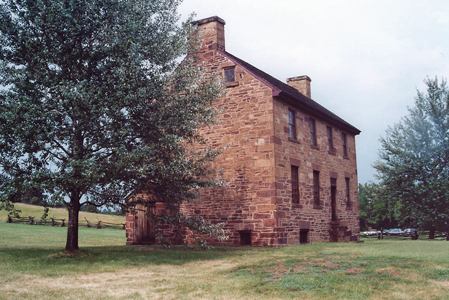 |
| The Stone Bridge | The Stone House |
After
walking around Henry Hill, we walked
down
to the Stone House.
The Stone House was a common landmark for both the Battles First and
Second Manassas. Used as a hospital for wounded soldiers, the house
still stands at the intersection of the Manassas/Sudley Road and the
Warrenton Turnpike. This intersection controlled the battlefield,
during Second Bull Run, allowing those who possessed it to move about with
relative ease. It was  this crucial junction
that Union General John Pope was able to save through the sacrifices of
the remaining Union brigades against the Confederate soldiers
coming over Chinn Ridge. If the Union Army had been pushed out of here,
a route to Washington, D.C., was only 30 miles away, would be open.
They have a Civil War guide/interpretor there to explain what went on
during the two battles. Shells can still be seen embedded in it's walls.
this crucial junction
that Union General John Pope was able to save through the sacrifices of
the remaining Union brigades against the Confederate soldiers
coming over Chinn Ridge. If the Union Army had been pushed out of here,
a route to Washington, D.C., was only 30 miles away, would be open.
They have a Civil War guide/interpretor there to explain what went on
during the two battles. Shells can still be seen embedded in it's walls.
We drove
out to the Stone Bridge. The Stone Bridge and the stream, Bull Run,
that flows beneath it are inseparably linked with the story of the two
battles of Manassas. Located on the Warrenton Turnpike, approximately
1/2 miles east of its intersection with the Manassas-Sudley Road (where
the Stone House is), it formed, during the first battle, the anchor of
the Confederate left and the objective of the Federal diversion under
General Tyler. Following the rout of General McDowell's Union forces,
it constituted one of the main avenues of escape north. During Second
Bull Run, it was the main route of the Federal advance AND retreat.
Though the bridge was destroyed a number of times and rebuilt, the
abutments at the bottom are
original (you can see Debbie and Damian waving from the top).
I got a chance to wade around in Bull
Run (at right) near the Stone Bridge.
Debbie, of course, was grossed out by this, but did take my picture.
The
water doesn't move very fast (if at all) and as you can see, it's
somewhat
muddy.
After that we went to dinner. We went to a rib
place, called The
Red Hot & Blue - Memphis Pit Bar-B-Que, that was plastered with
pictures
of Elvis Presley. Damian liked it because they had a free re-fill soda
machine. Debbie ignored the pictures of "The King". After dinner, we
went into Manassas (which is about 5 miles
from
the battlefield) for ice cream.
Second Battle of Bull Run
 On
Sunday, we went back to the battlefield. They
have an Auto
Tour that
takes
you to that follows along with the events of the Second Battle of Bull
Run. This battle was much larger, though with pretty much the same
results.
It was a 3-day battle that was fought from August 28-30, 1862. In the
battle,
Confederate General Robert E. Lee thoroughly defeated the arrogant
Union
General John Pope. On the left we see Damian literally "starring down
the cannons."
On
Sunday, we went back to the battlefield. They
have an Auto
Tour that
takes
you to that follows along with the events of the Second Battle of Bull
Run. This battle was much larger, though with pretty much the same
results.
It was a 3-day battle that was fought from August 28-30, 1862. In the
battle,
Confederate General Robert E. Lee thoroughly defeated the arrogant
Union
General John Pope. On the left we see Damian literally "starring down
the cannons."
In order
to draw Pope's army into battle,
"Stonewall"
Jackson ordered an attack on a Federal column that was passing across
his
front on the Warrenton Turnpike (modern day route 29) on August 28. The
fighting at Brawner Farm lasted several hours and resulted in a
stalemate.
Pope became convinced that he had trapped Jackson and concentrated the
bulk of his army against him.
On
August 29, Pope launched a series of
assaults
against Jackson's position along an unfinished railroad grade. The
attacks
were repulsed with heavy casualties on both sides. At noon, Confederate
General James Longstreet arrived on the field from Thoroughfare Gap and
took position on Jackson’s right
flank. On August 30, Pope
renewed
his attacks, seemingly unaware that Longstreet was on the field.
When massed Confederate artillery devastated a Union assault by Union
General
Fitz John Porter’s command, Longstreet’s wing 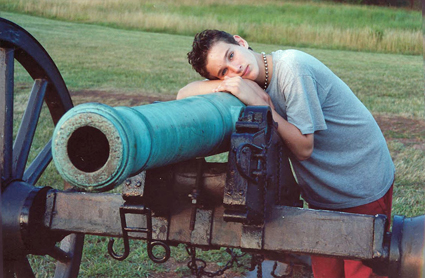 of 28,000
men
counterattacked
in the largest, simultaneous mass assault of the war. The Union left
flank
was crushed and the army driven back to Bull Run. Only an effective
Union
rearguard action prevented a replay of the First Manassas disaster.
With
this crushing victory, Lee would take the initiative after the battle
to
invade Maryland, culminating in the Battle of Antietam. On the other
side,
General Pope would be "retired".
of 28,000
men
counterattacked
in the largest, simultaneous mass assault of the war. The Union left
flank
was crushed and the army driven back to Bull Run. Only an effective
Union
rearguard action prevented a replay of the First Manassas disaster.
With
this crushing victory, Lee would take the initiative after the battle
to
invade Maryland, culminating in the Battle of Antietam. On the other
side,
General Pope would be "retired".
Union
casualties came to around 13,830 and
Confederate
casualties came to around 8,350 men. Combined casualties for the battle
were 22,180 men, which is over four times the 4,800 casualties from the
first battle. The best thing about an auto tour is that there is air
conditioning
(in the car) on a very hot day. We did stop though and hiked along the
Unfinished Railroad (the site of Confederate General "Stonewall"
Jackson's
defenses). On the right we see Damian and another Confederate cannon (a
brass 12-pounder Napoleon).
It looks like he has seen enough of Civil War battlefields for one day.
Washington D.C.
On
Sunday, we drove to Washington D.C., which
is around 35 miles north. We went to Washington
National Cathedral. We walked around and found the tomb of
President
Woodrow Wilson. We stayed for
the 11 am service. It's an Episcopalian Cathedral, so the service was
fairly
similar to a Catholic Mass. After the Service, we drove into Georgetown
for lunch. We went to a place called Clyde's of Georgetown on M Street.
After lunch we walked along the historic C&O Canal.
It was very hot that Sunday, easily hitting 100 (not to mention the humidity). Damian wanted to go to the Washington Monument. Unfortunately they were closing at 5 pm and all of the tickets for the day had been sold. I remember when they used to be open to Midnight in the summer, not any more. We than went to The Congressional Cemetery, I had a couple of photos to get (a vice president and a NJ governor). I had a map, so they were easy to find. Former FBI chief J. Edgar Hoover is here too.
We drove
back to Pennsylvania Avenue and
walked
around. The heat started to get to us, so we ducked into a Barnes &
Nobles to cool off. Damian went to the music section right away. After
we left, we went over to The
Franklin Delano Roosevelt Memorial. They have a lot of waterfalls,
so I figured it might be a little cooler. We visited here a number of
years ago, right after they opened it. It was during January, so it was
very cold. So, now we have seen it during both temperature extremes.
The Franklin
Delano Roosevelt Memorial is one of the most expansive memorials. The
memorial is divided into four outdoor galleries, one for each of FDR’s
presidential terms. The rooms are defined by walls of red South Dakota
granite with quotations from FDR carved into the granite. Water
cascades and quiet pools are throughout the memorial which makes it one
of my favorites. The first room deals with the Great Depression. It has
one of Roosevelt's more famous quotes, ""The only thing we have to fear
is fear itself." The second room is more on the depression. The third
and fourth room deals with World War II. There are a number of statues.
The most famous one, which was somewhat controversial when it was
unveiled, was the one depicting FDR seated with his dog Fala at his
feet. People criticized it because you couldn't see the wheelchair he
was sitting in with the exception of a small wheel in the back. FDR did
everything he could to hide the fact he was in a wheelchair and the
sculptor reflected that. Some people felt that he should be shown in
his wheelchair. Since my first visit, another statue of FDR is there
where you can see the wheelchair totally uncovered. There is a statue
to Roosevelt's wife, Eleanor in front of a seal of the United Nations
in commemoration of her role as one of the first U.S. delegates to the
U.N. This statue represents the first time a First Lady has been so
honored in a presidential memorial.
 |
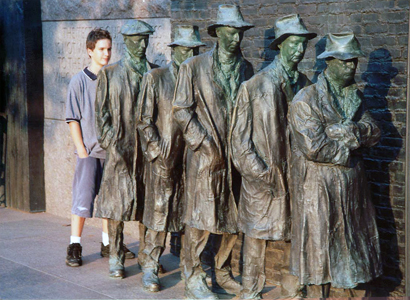 |
| Damian and I IN the FDR Memorial | Damian in line at the FDR memorial |
It was,
but not really enough. We went to
dinner
in Alexandria, Virginia to the Warehouse
Bar & Grill. Debbie and I went there back in 1996. Debbie loves
their crabcakes. Dinner was very good. I had the filet minion and
Damian
had the largest steak they had. We stopped in a Ben & Jerry's so
Damian
and I could get some ice cream. Than back to the hotel.
Mount Vernon
After this, we drove into Manassas for lunch. We went to the Philadelphia Tavern for some Philly cheesesteaks. Debbie said they were made the correct way. Since she lived in Philadelphia when she was in college, I took her word for it. After lunch we drove to Alexandria to visit Mount Vernon, George Washington's Plantation. Mount Vernon was home to George Washington for more than 45 years. The Estate was originally granted to Washington's great grandfather John Washington in 1674. It eventually passed to Washington's older half-brother, Lawrence, who renamed the property Mount Vernon after his commanding officer, Admiral Edward Vernon of the British Royal Navy. George Washington inherited the property upon the death of his brother Lawrence's widow in 1761. Over the years, Washington enlarged the residence and built up the property from 2,000 to nearly 8,000 acres. He divided the acreage into five working farms, including the Mansion House Farm, where he lived with his family.

 |
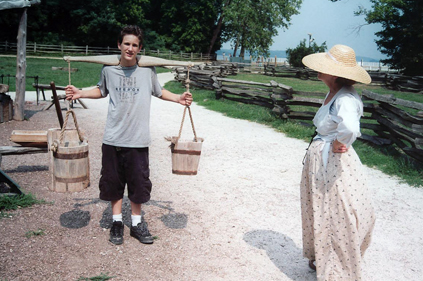 |
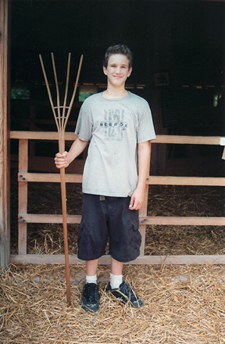 |

"Stonewall" at sunset